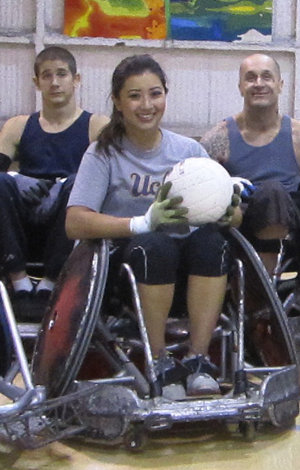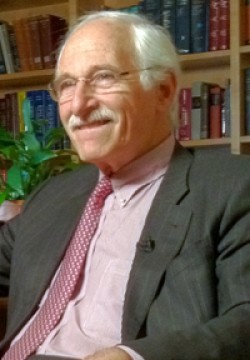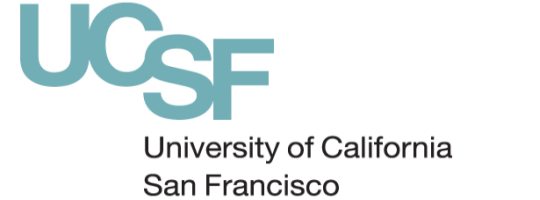From the Balance Beam to the State Bar.
From the Balance Beam to the State Bar.
UCSF Patient Turns Life-Threatening Condition into Source of Strength.
Angelica Galang loves competition. Feisty and determined for as long as she can remember, Galang became interested in gymnastics at the age of four after watching the U.S. women’s team win the team bronze medal at the 1992 Summer Olympics.
“We didn’t have a pool so I couldn’t be a swimmer and I just thought, ‘Well, let me try gymnastics,’” said the 23-year-old East Bay resident. “I have a living room and I have a couch, so I used to walk along the edge of the couch pretending it was a balance beam.”
…
UCSF Saves Life of Patient with Spine Tumor
Twenty three year-old Angelica Galang is a former gymnast. She was a fun-loving college student when her doctor discovered a five-inch benign tumor in her spinal column in 2009 after she fell down multiple times earlier that year. If the tumor had continued to grow, Angelica would have become a quadriplegic unable to breathe on her own.
Surgery to remove the tumor involved a very complicated procedure and only a handful (less than ten) of neurosurgeons in the United States are skilled enough to successfully perform it. UCSF Dr. Philip Weinstein performed the surgery in 2009.
Angelica is in a wheelchair now, but her tumor is completely gone and she doesn’t have to worry about not being able to breathe on her own. She recently applied to law school and got accepted by her number one choice: UC Berkeley School of Law.
…
At first Galang started practicing three hours a day, three days a week. Eventually her time commitment increased to more than 22 hours a week, when she started entering competitions. Angelica did well, winning multiple awards including a first-place finish in the California bar championship and contributing to a team gold medal.
“I loved the feeling of performing and it was really cool to be able to do the things that a lot of your friends couldn’t do,” she said. “The feeling of just sticking a landing or staying on the beam was really exhilarating.”
Galang hung up her gymnastics leotard when she entered UCLA as a freshman. She studied communications and political science with the goal of becoming a journalist.
A Life-Changing Diagnosis
During her junior year, the once graceful gymnast suddenly became clumsy and weak, falling down stairs and losing her balance. She dismissed throbbing neck pains as nagging reminders of old gymnastics injuries.
Galang started seeing a chiropractor near the UCLA campus in Westwood, California. An X-ray of her neck came back negative. Her MRI, taken weeks later, told a different story.

Angelica Galang, left, and her teammates with the United States Quad Rugby Association
“My orthopaedic doctor sat down and looked at me,” Galang recalled. “He said, ‘We’ve found something. There’s something very, very wrong and it needs to be treated immediately.’”
A five-inch tumor was growing in midway up Galang’s spine. The operation needed to save her life is one of the most complex spinal tumor surgeries.
When Galang’s doctor presented her case to some of the country’s top neurosurgeons, most of them refused to treat her, saying the surgery was “too risky.”
But one said yes: UCSF neurosurgeon Philip Weinstein, MD, agreed to operate on Galang.
“I felt confident that I could give her the best possible chance of coming through the surgery with preservation of as much spinal cord function as possible,” said Weinstein, a professor in the UCSF Department of Neurological Surgery. “The astonishing aspect of her case was that she had no neurological deficit at the time of initial diagnosis. She was functioning normally, yet there was this very large tumor occupying the entire central portion of her spinal cord.”
Galang bonded almost immediately with Weinstein, saying he was easy to trust.
“He was optimistic and I was very happy to have found him, especially after several other prominent neurosurgeons said no,” she said.
Without surgery, the tumor would have continued to grow, encroaching on vital functions. Ultimately, the condition would have proved fatal.
Reaching a Monumental Milestone
The surgery, which usually takes three hours, took almost 10 hours because the tumor was bigger than anticipated and it was in a precarious location – close to the C4 vertebrae. A spinal cord injury of C4 or higher typically paralyzes the diaphragm and the abdominal muscles, which control breathing. Using microscopes to guide microsurgical incisions, Weinstein separated the tumor from the spinal cord.
Waking up from the surgery, Galang found she couldn’t move her arms or legs, requiring members of her family to feed her. Sensation to her extremities started returning after about two months, but Galang still lacks fine motor skills, unable to write or even be able to feel how hot something is. She felt helpless and frustrated, especially when routine chores such as brushing her hair or putting contact lens in her eyes became Herculean tasks.
“I knew that the initial response to the surgery would be physically devastating, that she would require a long period of time to recover her functions,” Weinstein said. “She dedicated herself in a really inspiring way.”

Philip Weinstein, MD
After several months of intense physical therapy, Galang regained most sensation in her arms and some in her legs. Today, two years and seven months, after surgery, she is able to take a few steps with the aid of crutches, but mostly gets around in her wheelchair.
Galang’s perspective remains positive. Her adjustment has been on multiple levels.
“The disability is almost a bigger problem mentally than it is physically,” Galang said. “It really changes your outlook on a lot of things and your perspective on life.”
She returned to UCLA to complete her undergraduate degree. It was a difficult senior year for Galang, who quickly realized the hills of Westwood, once beautiful and welcoming to her, had become a challenging series of mountainous obstacles. The buildings she used to walk in without a thought were now a maze of wheelchair ramps and elevators.
When Galang graduated from UCLA last year, her thoughts were with those who helped her reach the monumental milestone. She faxed her diploma to Weinstein.
“Angelica is one of the most courageous patients I’ve ever had and one of the most remarkable young people I’ve ever met,” Weinstein said. “The day I heard she graduated from UCLA was one of the finest days in my neurosurgical career.”
Starting A New Chapter
As Galang began to understand the challenges ahead, she switched career paths from journalism to law, with the goal of helping people with disabilities. She took the LSAT (Law School Admissions Test) in the fall of 2011.
“I want to shatter the myth that people in wheelchairs are not going to be able to do things that able-bodied people can do,” Galang said. “I encounter a lot of little kids who come up to me and ask me why I’m in a wheelchair and their parents say, ‘No, no, no, no. Don’t do that; don’t look at her.’ And that sticks with the kids and they grow up thinking that there’s something wrong with people in wheelchairs.”
Galang applied to some of the top law schools in the country, including UC Berkeley’s law school, her number one choice.
Late last year just before Christmas, Galang received a call from Edward Tom, the admissions dean of Berkeley Law School.
She was accepted.
Looking back, Galang is at peace with the recent turn of events, even with the tumor that almost ended her life. She is even grateful for what happened, even if she may never walk unaided again.
“My life before all this was mostly about me. I never would have found this renewed perspective on so many things,” Galang said. “I’ve met the most inspiring and the most memorable people because of this injury. And I now have a new purpose in life, a goal much bigger than myself.”
The former gymnast who used to balance herself on the edge of her living room sofa now has a new athletic passion: wheelchair rugby. She became interested in the sport after her boyfriend introduced her to “Murderball,” a 2005 film about paraplegic athletes competing in full-contact rugby with wheelchairs specially designed for impact.
During a practice session one January evening with members of the United States Quad Rugby Association, Galang was the only woman among a group of eight athletes. A fierce competitor by nature, she is one of the more productive members of the team, known to her friends and teammates by her nickname, Jelly.
“Jelly has great reflexes and great intuition,” said Scott Pope, team captain of the Northern California chapter of the U.S. Quad Rugby Association. “She’s not afraid of anything and just goes for it. I love that about her.”
After a non-stop two-hour practice session, Galang winds up dripping with sweat and out of breath, but smiling. She is proud of her accomplishments and grateful for the lives she’s touched – and those who have touched her – in spite of, or maybe, because of her injury.
“I love my life, I love how many people that I’ve met through this and how many friendships have grown because of this,” she said. “It’s really a gift and I would never, ever return it.”
…
Wheelchair Rugby Athletes Practice at Riekes Center
UCSF patient Angelica Galang and members of the United States Quad Rugby Association (USQRA) practice at Riekes Center for Human Enhancement, located in Menlo Park. USQRA exists to provide opportunity, support, and structure for competitive wheelchair rugby to people with disabilities. For more info, go to http://www.quadrugby.com
…
By Leland Kim
Public Information Representative
University of California, San Francisco (UCSF)
###
> About University of California, San Francisco (UCSF).
The University of California, San Francisco (UCSF) is a leading university dedicated to promoting health worldwide through advanced biomedical research, graduate-level education in the life sciences and health professions, and excellence in patient care. It is the only UC campus in the 10-campus system dedicated exclusively to the health sciences.
More about University of California, San Francisco (UCSF).
More about University of California, San Francisco (UCSF). Information.
###
* The above story is adapted from materials provided by University of California, San Francisco (UCSF)
________________________________________________________________




















